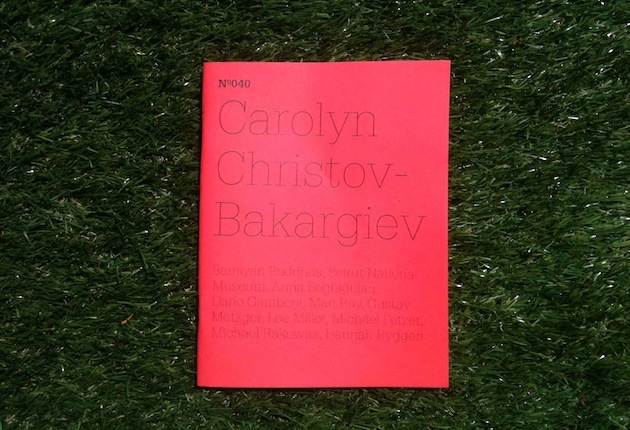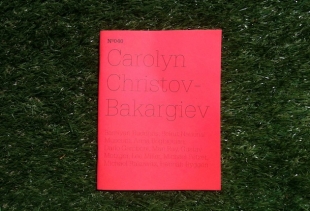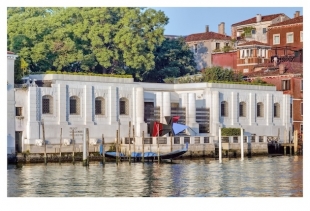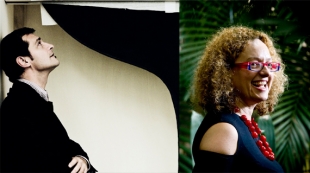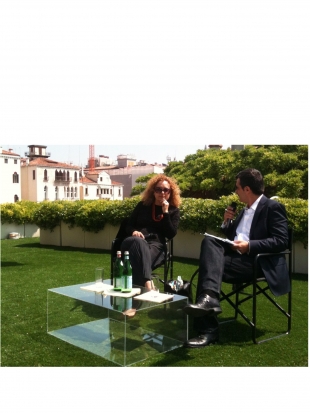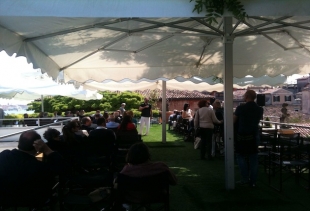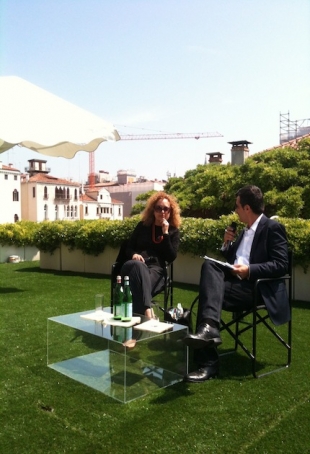» archive blog
-
Carnal, issue 0 of Parterre de Rois
A new magazine in Milandate: 18-07-2013
-
Interview with Nicola Toffolini
A worlds inventordate: 24-04-2011
-
Donne senza uomini.
Installazione multimediale di Shirin Neshatdate: 01-03-2011
dOCUMENTA 13, a conversation in Venice /Chiara Fumai among the selected Italian artists
The traffic controller of 13th Edtion, Carolyn Christov-Bakargiev: a "no concept" show
No scoop as usual about the artists’ list of the next dOCUMENTA 13 when only 30 days are lacking for the opening time: on its place a gigantic list of 150 in alphabetic order is on the event website – mixing authors, artists, philosophers, scientists to poets and architects. To wait the definitive one it is needed to be in Kassel on June 6 to the press preview at noon or on June 9 at the official opening (dOCUMENTA 13 ending day will be on 16 September 2012).
Carolyn Christov-Bakargiev, traffic controller rather than artistic director (this is her definition!) of the biggest German event, shared her guidelines in a sunny public conversation en plein air on the stunning terrace of Peggy Guggenheim Collection in Venice (with Luca Massimo Barbero), crowded by art collectors and lovers, press and friends of the museum (thanks to the sunny, summer-like day and the calibre of the invited speaker). Windowed on the Grand Canal, audience was busy to rush from a high philosophical paradox to an art history quotation to another and jumping and digging positions of artists like Capogrossi, Massaccio, Giotto until Picasso and others who were banned by the Hitler’s regime until become stars of the first Documenta edition. Meant to be a one-off show with no second edition as the majority of the events organized by artists or curators or producers over every latitude, Documenta became instead a periodic event with a long, unparalleled fortune. Differently from the other big art appointments that are very taken in consideration by the art world as Venice art Biennale (that is every two years and organized on national base and criteria), Kassel is also strongly attended by an unwitting public or a not-specialized audience. It is in facts and mission much more a cultural event on arts of today and yesterday than every other else (Documenta means lectures). It has been strongly helped in this position also from the fact to take often place in public domain and not only in pavilions or museums with admission fees.
dOCUMENTA by Christov loves - above all the words in the video and text glossary on the event website – to repeat “wordly”, but not in the semantic meaning (or in the acoustic perimeter of the spelling) maybe similar to the one of Daniel Birnbaum (Making worlds): the curator aims the same allure of universe of practices, without making of "interdisciplinary" a mantra. She likes to make a podium in which let meet, without overlaps or mandatory schedule to sign a work in two, “for a dinner, for a night” nuclear scientists, poets, architects and artists in order to offer them a new complexity or variety and/or plurality of viewpoints, that means languages but also practices and knowledge and inspiration and, yes, also theories but only if these latter are not eating everything else.
A think was clearly stated without fear to understand its contrary (by echoing Adorno): dOCUMENTA is luxurious for those are called to sign it (she also thanks Szeman and David, two of the former directors at Kassel, to have enlightened her past) because appointed curators have four years to work on and, in these, three months to install the artworks. We also add that they have a big budget if we look at it with the ratio of the population resident in Kassel and to what, for example, happen in Italy, for a show lasting only 100 days.
Kassel Municipality, the Land and the Central Government sponsor dOCUMENTA 13 with 3 Mln Euro each and then there are three other private donors (an automotive company, Wolksvagen; two banks, Deutsche and Sparkasse). Christov defines it a “grand expenditure in the right place”. Yes, audience figures declared the past edition are stunning for a city that has been a cultural reference in Germany (after Berlin and Munich) only many years ago: 750.000 (almost two times the visitors of Venice Art Biennale).
If the artist list is still undercover, the flavour of what we find at Kassel 2012 has been described. Further to the presence of “agents” of different disciplines, we will expect massive interactions of cultures that are usually far each other, better if widespread by “expat” who moved on the idea to return back to their original territories. And new names taken from Middle East, especially Lebanon that counts on four invited artists (“the major figure if compared with the tiny popolation of that country”, according to Christov). Beside this, 100 originally designed “notebook” editions in brilliant colours on covers and different formats (except A4 that is not bridging, instead is dividing, US and Italy for instance, says the curator). Pamphlets are comprised in the 3 partitions catalogue but are also sold alone and have been also feeding this long four years buffer time with expectations, themes and conversations picked all along what we imagine will constitute the show. Each notebook will be in 2000 copies: the publisher Catje Hainz would rather like having done 20.000 of each but Christov explained she felt more adaptive the number 2000 to render each title (and its contents) a more careful and reserved object. To choose and buy with care.
Christov attempts above all to mitigate the role of the curator that many parts of the scene is occupying despite the artists and sometime damaging them.
Interested to four of the moments of creation (when artists are on stage, when are under siege, when are in a moment of hope, when are in a isolation phase to create) she concentrated on making a “no concepts” show. Where to privilege the research of the break with a certain discoursive turn typical of the Documenta of Catharine David (“we are very similar on many aspects and not only because we are women, but we differentiate on this!”) and go for empiricism and scepticism, to do not surrender to the vague dominating the industry.
When I’ve asked which material, for necessity, the youngest artist she invited has used for his/her piece, the curator answered it is objects mixed with persons in a new way that is not resembling simulation art or appropriation or performative or relational art.
The only thing we can do is to discover soon what she was referring to with this mixture and what she means when she says that there is a new way to let put people and things in relation that have never yet written in art still. Able also to make worlds or new dictionaries for shared practices.
A post-it writte on 7 June:finally the list is unveiled! We will be not in Kassel for the opening days as scheduled (we will visit Documenta after Basel). Among the Italian artists selected by the artistic director the biggest (and positive) surprise seems to us Chiara Fumai - multi-talented artist with a background in architecture, a strong and in-depth interest for music and a long-term dj practice with a preference for Italo Disco and techno. She started as visual artist at Care Of (Milano). Even if we did not yet see the artwork she premiered at Documenta, her relation with objects and the persons, especially in a fictional level, is high level even if she is a beginner.
To check the full list of artists participating:
http://d13.documenta.de/#participants/participants/?tx_participants_pi1[showUid]=8&cHash=4854ab2356fa8a09b61010193f12b14f

